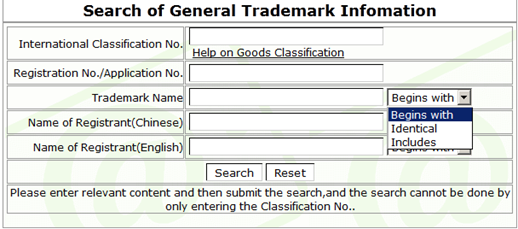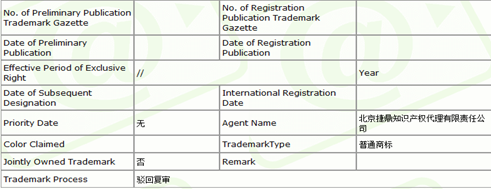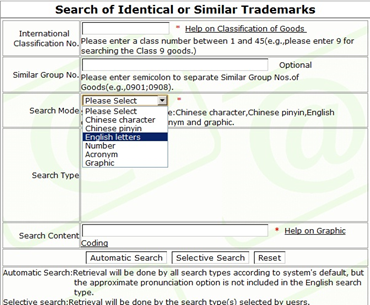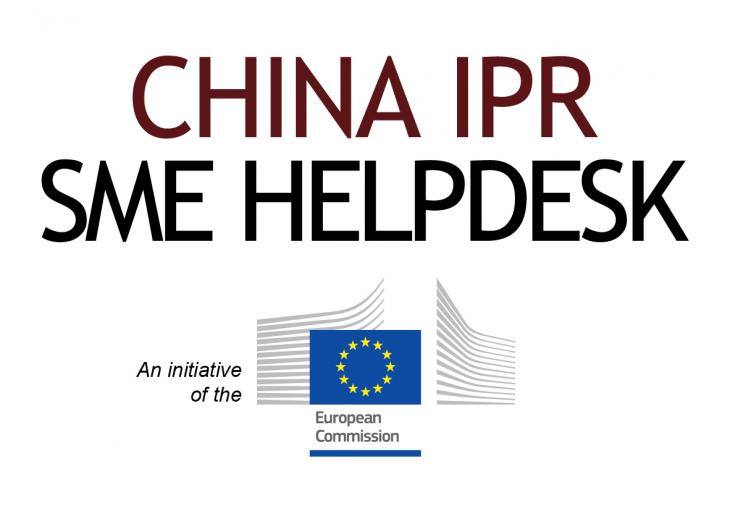How to Conduct a Trade Mark Search in China
Every company, no matter how big or small, has some intellectual property (IP). The most common type of IP right is a trade mark. A trade mark is essential to all kinds of companies, whether you are a producer, distributor or service provider, as it allows clients to distinguish you from your competitors and builds the image and reputation of your brand.
International laws, including Chinese laws, grant legal protection to trade marks providing they comply with a few basic requirements: the mark must be distinctive; must not have previously been used by others in the same market; and must not describe the product, e.g. you cannot register ‘apple’ as a trade mark for apples.
Trademarks are territorial in nature and therefore must be registered in every country. A trade mark registered in Spain, for example, is not automatically valid in China. If you want to obtain protection in China you must register with the China Trade Mark Office (CTMO) either by directly filing a domestic application or by filing an international extension through the Madrid System.
Why conduct a trade mark search?
Before you apply to register your trade mark in China you should check that it is available and has not been previously registered by another company (known as a ‘bad-faith’ registration), or is too similar to any other registered trade mark. This step will prevent you spending resources on an application which will be rejected and could delay your business operations in China.
Trade mark agents can conduct a trade mark search on your behalf but you can conduct an initial search by yourself on the CTMO online database which records all trade marks applied for and registered in China. The database is available in English and is free to use. Please note that there may be a delay of up to several weeks between some applications being filed and appearing on the CTMO database.
Step-by-step guide
The CTMO online database can be used to search for all trade marks registered or currently in the application process in China. The database is available in both Chinese and English.
The CTMO recommends using Internet Explorer 6.0 to conduct the search as other browsers do not display the information correctly.
Before you begin please accept the disclaimer in order to continue with the search. As the disclaimer states, the information available on the database may not be 100% up to date and therefore can only be considered a preliminary search.
To begin you need to choose one database:
- For a basic search - SGTMI
- For an advanced search for identical or similar trade marks - SISTM
- For trade mark application status - STMAS
Basic search for identical trade marks
The SGTMI database allows you to make a basic trade mark search to show whether any identical or almost identical trade mark has already been registered in China. This search is particularly useful to check for ‘bad-faith’ registrations in China.
The SGTMI is a simple search engine which allows browsing by entering information into one or more fields. No field is compulsory but the more information you provide the better the results:
- International Classification no.
- Chinese trade mark registration or application number – this search term can only be used if you know the registration number of a trade mark which has already been registered in China.
- Trade mark name - includes the possibility to search for trade marks which are identical to the search term, which begin with certain letters, or which include the searched term. The selection of searching alternatives may be particularly useful for different types of marks, for example:
- Use the ‘begins with’ search field for trade marks where the first element is the most distinguishing and the other elements are generic, e.g. Apple Inc., Dell Inc., Google Inc.
- You can use the search for ‘identical’ marks if the name is short.
- The ‘includes’ field may be useful in order to find all the marks which contain some popular prefix or suffix e.g. -ex, -extra, - natural.
- Name of registrant - name of the right holder either in Chinese or in English if known.

By clicking on the result from your search you can see the full trade mark information: The trade mark information contains the following data:
- Registration no./application no. – every mark in each class of goods in China has a separate number. For example, the trade mark ‘European Chamber’ is registered as two separate trademarks, 8758425 in class 41 and 8758426 in class 35.
This differs from most European countries where a trade mark is registered only once and the same registration can cover a number of classes. Numbers starting with the letter ‘G’, indicate that the trademark was first registered in another country and has been extended to China.
- International classification number – every trade mark must be registered in one of the 45 classes of goods and services.
- Application date – this refers to the date on which the CTMO received the trade mark application.
- Name and address of the registrant – in English and/or Chinese.
- Representation of the mark – the image may sometimes appear upside down due to a technical problem.
- List of goods and services – lists all the goods and services covered by the trade mark. Information in this field is only available in Chinese.
- Similar group – includes the International Classification number and the subclass number, e.g. 4101 indicates international class 41 and subclass 01.
- Trademark Gazette Publication – the Trademark Gazette is an official publication of CTMO including all trade mark related matters including preliminary approval, approval, renewal, modification etc. In addition to the printed Gazette it is available online in Chinese only. The date of Preliminary Publication and Registration Publication are important if you find your trade mark has been registered in bad-faith by another company.
- Preliminary publication – following preliminary publication an opposition can be filed with the CTMO within three months. This may mean you can prevent a potential bad faith registration.
- Publication of registration – this date indicates that the trade mark has been successfully registered by the CTMO.
- Effective Period of Exclusive Right – trade marks can be perpetual but must be renewed every ten years in China.
- Other information including:
- Date of subsequent designation – relevant for international registrations.
- International registration date – relevant for international registrations.
- Priority date – the date of the first filing abroad.
- Agent name – name of the legal representative if applicable.
If the trade mark remains under examination, i.e. it is still in the application process and has not yet been published in the Trademark Gazette, most fields will be empty and will contain the following information on the examination process:

The ‘Trademark Process’ field indicates the current stage of the registration process. This field may include no information or the following in Chinese only. Click on the field to link to the next page which contains more detailed information in Chinese:
|
驳回 = refusal |
变更 = modification |
争议 = dispute |
|
领土延伸 = territory extension |
异议 = opposition |
续展 = renewal |
|
期满未续展 = no renewal after expiration |
驳回复审 = refusal and review |
转让 = transfer |
Advanced search for similar trade marks
If you want to search for trade marks which may be considered similar to your trade mark, you can use the SISTM database. This is recommended because trade marks which are too similar to existing trade marks will not be granted by the CTMO. Please see the text box below on ‘How Similar is Too Similar?’.
The process is similar to the basic search, but you must input the International Class No. and a minimum of one other search term.
The database can search marks in Chinese characters, Chinese pinyin, English letters, numbers, and acronyms, and by graphic elements.

After the search: next steps
If your trade mark is not in the database:
This probably means that your trade mark is available and therefore we advise you to begin the process of registration with CTMO as soon as possible. If you do not have residency or a place of business in China you must apply through a local trade mark agent. A list of qualified trade mark agents can be found on the CTMO website. If you are planning to register the trade mark in Europe you can extend the registration to China through the Madrid Protocol. For more detailed information on trade mark registration please see the China IPR SME Helpdesk publication ‘Guide to Trade Mark Protection in China’.
Please note that it is possible that a trade mark application has been filed but the information is not yet available online as per the disclaimer mentioned above.
If your trade mark is in the database:
This may mean that your trade mark has been registered in ‘bad-faith’ and is now effectively owned in China by someone else. At this point your options include:
- During the three month period between the bad-faith registration of your trade mark being published in the Trademark Gazette and the trade mark being granted, you can file an opposition with CTMO.
- If the trade mark has already been registered, you may be able to have the registration invalidated by filing a case with the Trade Mark Review and Adjudication Board (TRAB). The chance of success will depend on the specifics of the case.
- It may be possible to buy the trade mark through an online ‘supermarket’ or by negotiating directly with the trade mark owner, or through an intermediary such as a lawyer or trade mark agent.
Take-away message:
Early registration of trade marks in China should be considered key to protecting your business even if China is not your primary market. Consulting the CTMO database is a relatively simple way of establishing if your trade mark is already owned by someone else or assessing if a trade mark that you wish to register is too similar to one that already exists; taking such actions can save your business time and resources.
China IPR SME Helpdesk Team

The China IPR SME Helpdesk supports small and medium sized enterprises (SMEs) from European Union (EU) member states to protect and enforce their Intellectual Property Rights (IPR) in or relating to China, Hong Kong, Macao and Taiwan, through the provision of free information and services. The Helpdesk provides jargon-free, first-line, confidential advice on intellectual property and related issues, along with training events, materials and online resources. Individual SMEs and SME intermediaries can submit their IPR queries via email (question [at] china-iprhelpdesk.eu) and gain access to a panel of experts, in order to receive free and confidential first-line advice within 3 working days.
The China IPR SME Helpdesk is an initiative by the European Union
To learn more about the China IPR SME Helpdesk and any aspect of intellectual property rights in China, please visit the online portal at http://www.ipr-hub.eu/.
